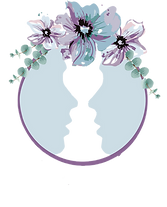Sustainable Church Flowers: Beauty That Blooms With Purpose
- Debbie Davies

- Apr 21
- 3 min read
As Floral Designer Louiseanddeb, we’ve always believed that flowers hold a sacred place in our lives. From weddings to funerals, from Easter altars to Christmas nativity scenes, they quietly accompany us through life’s most poignant moments. But behind their beauty lies a story—one that often goes untold. As flower lovers, florists, and faithful parishioners, it's time to ask: Can our church flower arrangements reflect not just God's creation, but our care for it too?

Why Sustainable Church Flowers Matter
The Sustainable Flowers Research Project (SFRP) brings together voices from every corner of the flower supply chain to work toward a more ethical and environmentally friendly flower industry. Their findings shed light on the many hidden impacts of modern floristry, especially when 90% of flowers sold in the UK are imported from countries like Kenya, China, and the Netherlands.
Some of the major sustainability concerns in flower production include:
Water Use: Flower farms in drought-prone areas divert precious water, affecting local communities and ecosystems.
Chemical Runoff: Fertilizers and pesticides contaminate water sources, with harmful effects on people and biodiversity.
Carbon Emissions: Global transportation, greenhouse growing methods, and refrigeration contribute heavily to the flower industry's carbon footprint.
Labour Issues: Workers often face unsafe conditions, irregular employment, and in some regions like Ethiopia, systemic discrimination and unrest.
And yet, these problems are rarely visible to those of us who simply want to place a beautiful bouquet on the altar.
The Certification Conundrum
Efforts to make floriculture more sustainable are growing—but certification is a mixed bag. Programs like Waitrose Foundation, MPS Sustainable Quality, and VVS Voluntary Sustainable Standards each focus on different aspects: some emphasize worker welfare, others water usage, and still others carbon emissions. But with no single unified standard, it's hard for consumers—or church volunteers—to know what "ethical flowers" truly mean.
From 2026, Aalsmeer Flower Auction, one of the largest in the world, will sell only certified flowers. This signals a powerful shift in the industry, but it's still up to local communities to drive change from the ground up.
How Churches Can Lead the Way
Churches are uniquely placed to be stewards of creation. Here are some practical ways to bring sustainability into your church flower arrangements:
🌼 Grow Together: Create a Local Flower Collective
Encourage parishioners to form or support a local flower-growing hub. Whether it’s a patch in the church garden or a network of backyard growers, seasonal British flowers reduce transport emissions and reconnect us to the land.
🪴 Share the Bloom: Donation Buckets
Set up a “Flower Donation Bucket” where people can drop off surplus garden blooms. This not only supports sustainability but invites community involvement and deeper connection to the arrangements displayed in your church.
🐔 Reduce the use of Foam: Chicken Wire Mechanics
Reduce the use of floral foam! While it may be convenient, it currently contains harmful micro plastics. Leading manufacturer Oasis is working hard reinventing floral foam with their new plant based product ‘Renewal,’ but until this is readily available at an affordable cost, use chicken wire, moss, or reusable metal frames in buckets and urns. They’re sustainable, and many florists find them even more effective for large-scale displays.


📰 Spread the Word
Use your church magazine or newsletter to highlight the impact of flower production and share stories from sustainable flower growers. Educating parishioners empowers them to make mindful choices, whether arranging flowers or buying a bouquet.
🌍 Learn from the Leaders
Look to resources like:
AIPH Sustainability and Sustainable Floriculture reports
Guides from Events Sustainability and local flower hubs
A Movement Rooted in Faith
At its heart, sustainability is an act of faith—faith in the future, in creation, and in the belief that small, intentional changes can reflect a deeper love for our planet and one another. Let’s allow our church flowers to bloom with that purpose.
Together, we can turn our flower arrangements into not just displays of beauty, but acts of hope and stewardship.






Comments